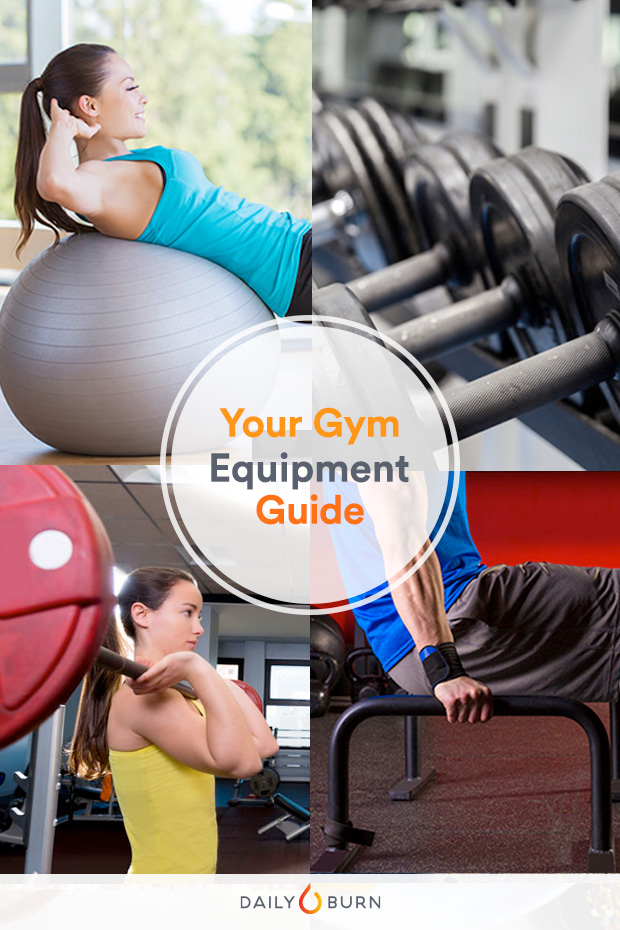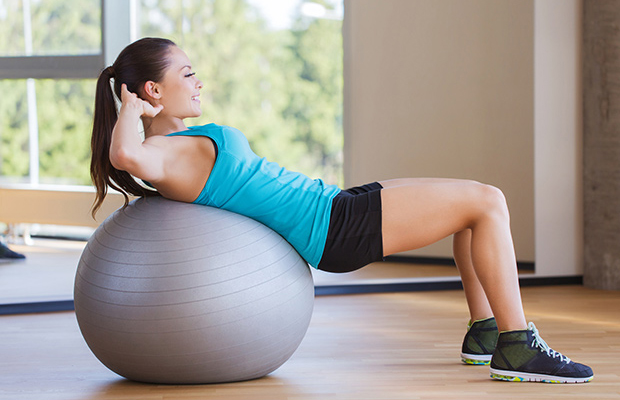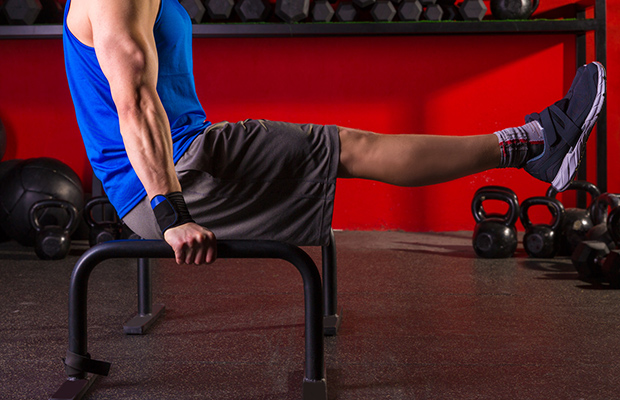
Gym-timidation is real.
One of the biggest fear factors? The wide range of crazy looking training tools littering the weight room floor. And we’re not just talking about the usual suspects like barbells, dumbbells and medicine balls. These days, you’re likely to find everything from sandbags to suspension trainers to gymnastics equipment like parallettes.
How exactly do you use this equipment without looking like a fool or worse, hurting yourself? We tapped fitness experts Jenny Harris, a Daily Burn Fitness/Nutrition Coach, and Pete McCall, MS, CSCS, a San Diego-based personal trainer and strength coach, to help us make sense of the most common strength training equipment you’ll find at the gym.
RELATED: The 20 Worst People at the Gym, According to Trainers
Your Strength Training Equipment Gym Guide

1. Dumbbells
A staple in most weight rooms, dumbbells are a good place to start if you’re new to strength training. Most gyms are equipped with dumbbells ranging from 1 to 100 pounds. “They’re really good for strength building,” says Harris. “They are more joint friendly. Because your hands aren’t in a fixed position, they allow your body to move in a more natural motion.” (Need inspiration? Check out this functional dumbbell arm workout.)

2. Barbells
Nope, these aren’t just for Olympic lifters and bodybuilders. Barbells can be a lifter’s best friend for moves like back squats, deadlifts and snatches. “Barbells allow you to go so much further [than dumbbells] because you can add on so much more weight,” says Harris, referring to the 2.5 to 45-pound weighted plates you can side onto to each side of the metal bar. Keep in mind, the bar itself can weigh anywhere from 45 pounds, so be sure to figure that into your calculation. And if you’re not quite ready to go heavy, opt for fixed barbells (which are usually grouped together on a rack and start at 10 or 20 pounds).
RELATED: 5 Beginner-Friendly CrossFit Workouts
3. Body Bars
Body bars are iron bars covered in foam rubber, making them a friendlier (and lighter weight) alternative to standard barbells. “These bars allow users to perform all types of barbell exercises with weight that can be easy to use for beginners,” says McCall. For experienced lifters, while body bars may not provide enough of a challenge for your main set, Harris suggests using them to warm-up for exercises requiring a standard barbell. Or, put them to use in this 5-move BodyPump circuit for beginners.

4. Kettlebells
The cannonball-like weight with a single loop handle looks like something out of Game of Thrones but it’s a great way to build power. Many of the classic kettlebell exercises, like kettlebell swings and cleans, require you to move the weight quickly and powerfully. (It’s also a sneaky way to work in some heart pumping cardio.) And, since the weight isn’t balanced like a dumbbell and shifts when you move it, your body must work harder to stabilize. “Kettlebells teach your body to adapt to changing center of gravity,” says Harris. Never used kettlebells before? It’s worth asking a trainer for some pointers on good form.
RELATED: 5 Kettlebell Mistakes (And How to Fix Them)
5. Resistance Bands
They may look like giant colored rubber bands, but resistance bands provide a surprisingly effective workout. “It’s low-impact and joint friendly,” says Harris. “Since the band creates resistance in both directions, it forces your body to stay stable while in motion.” Choose your desired resistance level, length and style (you’ll find everything from tube bands with handles to flat bands to closed looped bands), and get accustomed to that tension. Resistance bands are perfect for exercises like overhead presses, squats and lateral band walks (a seriously effective dynamic warm-up move!). Bands can also be a good intro to strength training for someone who’s new to the gym and an easy-to-pack piece of equipment when you travel.

6. TRX
The unassuming straps hanging from your gym’s ceiling are really an all-in-one gym. “There are a huge variety of exercise you can do,” says Harris. “One of the biggest benefits is it’s a [dynamic] as opposed to isolated movement. You work multiple muscle groups at once.” For example, slip your feet into the TRX handles and your regular push-up turns into a core and shoulder-stabilizing move. And since you’re using just your bodyweight, you can adjust the resistance by moving your feet closer (less resistance) or further (more resistance) away from the anchor point.
RELATED: The 20-Minute TRX Workout
7. Sandbags
Sandbags are just like they sound — weighted bags of sand that look like big duffle bags. Press them up, slam them down and slide them across the floor like a total champ. Or, incorporate them into your usual strength training routine via squats, lunges and carries. “Sandbags are a great way to mimic functional fitness and to get you ready for daily life activities, whether moving bags of fertilizer, picking up your kids or carrying bags of groceries,” says Harris. And how’s this for an added challenge: “The sand shifts as the bag is moved, challenging the wrist and forearm muscles to work harder to control the movement of the weight,” says McCall. Get started with these five functional moves.
8. ViPR
That funny looking hollow tube you’ve seen at the gym? No, it’s not a new type of foam roller. It’s the ViPR, a tool that builds mobility, stability and dynamic strength through loaded movement training. Because you can pick it up and shift it in space, the ViPR mimics real-life and sport-based movement and forces your whole body to work together. Think forward lunges with rotation, or lateral lunges swinging the ViPR over and up, as if you’re digging with a shovel.
“The benefit of using the ViPR is that it can help improve the strength and resiliency of muscle and connective tissue, making it more resistant to many types of strain injuries,” says McCall, who’s also a ViPR master trainer. “As the muscle is lengthened under resistance, it becomes stronger because it adds collagen to help improve the strength and density of the tissue.” You can change the intensity of the movement based on how you hold the ViPR and how you move the tool in relation to your center of mass so moving it away from your body makes it harder.

9. Medicine Balls
Think of medicine balls as chicken soup for the swole. You’ll often see people use these basketball-shaped weights to add resistance to core exercises like sit-ups or Russian twists. But they’re meant to be carried, lifted and thrown. “Moving [medicine balls] in multiple directions and planes of motion can involve more muscle tissue, which elevates energy expenditure,” says McCall. Harris likes to use them with plyometric exercises as a way to build explosive strength.
RELATED: The 15-Minute Medicine Ball HIIT Workout
10. Slam Balls
Slam balls are slightly larger (and sometimes heavier) versions of medicines that don’t bounce. That means you don’t have to worry about a heavy ball bouncing back in your face after slamming it to the ground. (Ouch!) “They’re great for developing power, speed and strength,” says Harris. “It’s one of those exercises that builds on itself. The faster and more powerful you throw the ball, the more your muscles will respond to it.” To get in on the action, just make sure you’re in a slam-safe zone. (Gyms will often post where you can and can’t use such equipment so you don’t go busting a hole through a wall.)

11. Stability Balls
These giant inflatable beach ball-like tools are another way to up the anté on strength training exercises. “Stability balls are good for bodyweight exercises that focus on the core muscles that attach the pelvis to the femurs and spine,” says McCall. Think crunches, push-ups (hands or feet/legs on top of the ball), hamstring curls and pikes. They can also help to increase spine stability through moves like back extensions and planks. “This can be good for someone who spends a lot of time at a desk or sitting in a chair,” says Harris. Ready to roll? Start with these five moves here.
12. BOSU Balance Trainer
Next to the stability balls, you’ll likely find the BOSU Balance Trainer, what looks like a stability ball cut in half. It stands for “both sides utilized,” meaning you can use both the dome stability ball-like side and the flat platform for exercises. “The benefits of the dome side are that you can do exercises like crunches on a soft surface that allows a full range of motion of the spine. It also creates an unstable surface which can be helpful for developing strength in the foot, ankle and lower leg,” says McCall. “Standing on the flat is creates a unique balance platform which can be helpful for engaging lower body muscles.” And it’s great for building dynamic balance — the ability to balance while in motion or changing positions, which is key for active lifestyles.

13. Gliding Discs
You may be tempted to overlook these plate-size disks at the gym. Don’t. Use them to crank up reverse or lateral lunges (place one foot on the disk and glide into the lunge and back to the starting position). You’re guaranteed to feel your core, glutes and inner thighs light up. Harris likes to use them for ab exercises like mountain climbers and pikes. “Because you take resistance away from your feet, your core has to do all the work of stabilizing your body,” says Harris. And if you can’t find these at the gym, grab two small towels to get the same slippery effect underfoot.
RELATED: The Game-Changing Towel Workout

14. Parallettes
Commonly used by gymnasts and CrossFit athletes, parallettes let you test (and push) the limits of your physical strength. “Gymnastics exercises are excellent bodyweight training for developing strength and definition, but not many gyms have space for parallel bars. [Parallettes] are smaller bars that allow you to do exercises like handstand push-ups, L-sits an other gnarly feats of strength,” says McCall. And since they’re raised off the ground, you can move into a deeper range of motion with each exercise.

15. Battle Ropes
Looking for an intense but stress-relieving workout? Try battle or battling ropes. (Cue baller inspiration HERE.) Grab one of these giant ropes in each hand and begin lifting the rope up and down explosively, creating waves. The higher the wave, the more energy you’re pouring into the rope. “The challenge is keeping them moving at a fast rate,” says McCall. “Using battling rope is like doing sprints for your upper body.” And you can’t cheat. “They’re really good for fixing imbalances because you’re using both sides of the body to do separate work,” says Harris. “You don’t have one side overcompensating for the other.” Plus, talk about forearm and grip strength!
